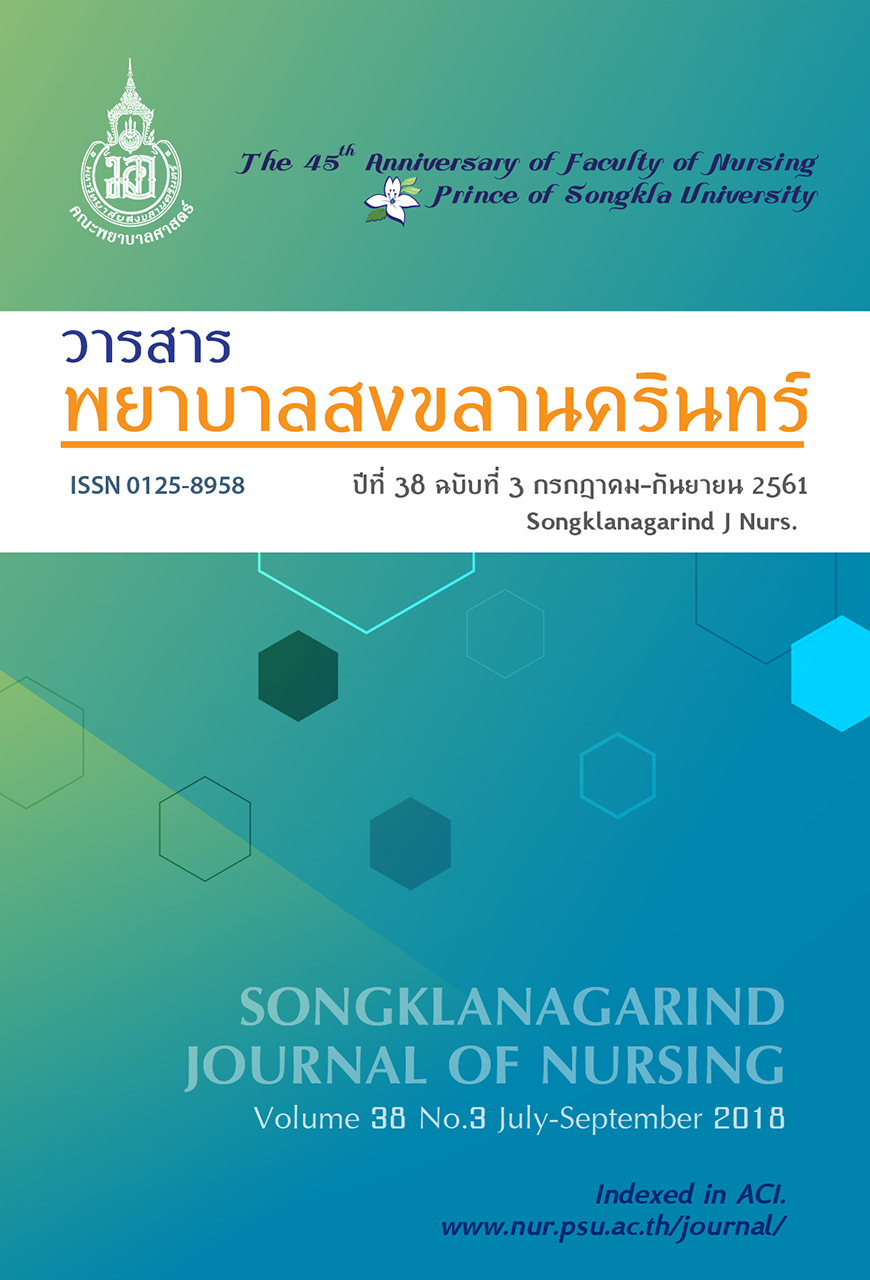Effects of the supportive program and application towards care behavior of caregivers of newborns with neonatal hyperbilirubinemia undergoing phototherapy
Main Article Content
Abstract
The quasi-experimental research aimed to study the effects of the supportive program and application
towards care behavior of caregivers of newborns with neonatal hyperbilirubinemia undergoing phototherapy.
The sample consisted of 30 caregivers that were divided equally into two groups (experimental and control
groups). The samples were purposively selected. The samples was trained with the supportive program and
application, including 1) teaching through the application, 2) guiding and following for being aware of care,
3) supporting and ensuring the continuity of care, and 4) demonstrating clear procedures. The control group
received regular nursing care. The data collection tool was the questionnaire on care behaviorof caregivers
of newborns based on Orem’s conceptual framework. Data were analyzed by Independent t-test and Paired
t-test.
The results showed as follows. 1) after the experiment, the mean score of caregivers’ care behavior
in the experimental group was statistically significant higher than those in the control group at 0.05. 2)
after the experiment, the mean score of caregivers’ care behavior in the experimental group was statistically
significant higher than that of before the experiment at 0.05.
The supportive program and applicationcan be used as a guideline for nursing careto properly and
continuously promote care behavior of caregivers of newborns with neonatal hyperbilirubinemia undergoing
phototherapy.
Article Details
References
2. Thai Neonatal Society. Newborn care guilde. Bangkok: Thai Neonatal Society; 2008. Thai.
3. Information Technology Department. Annual statistical report. Nakhon Phanom: Nakhon Phanom Hospital; 2017. Thai.
4. Prawannao N, Kiatchoosakun P, Jirapradittha J, et al. Neurodevelopment outcomes of infant with severe hyperbilirubinemia in Srinagarind Hospital. Thai journal of pediatrics. 2012;51(2):120-26. Thai.
5. Prasomsak K. Effect of an educative and supportive program on the anxiety of parents who have infants with hyperbilirubinemia and received phototherapy during the postpartum period. [thesis].[Bangkok]: Mahidol University; 2008. 61p. Thai.
6. Siriboonpipattana P. Pediatric Nursing Volume 1. Nonthaburi, Praboromarajchanok Institute Welfare Fund: Ministry of Public Health; 2012. Thai.
7. Kiatchoosakun P. Neonatal hyperbilirubinemiain: In: Kirdpon S, editor. Pediatrics. Khon Kaen: Anna Offset Printing; 2009. Thai.
8. Boonyarittipong P, Boonlueang W, Tantrachee- wathorn S. Effectiveness of intensive phototherapy in neonatal hyperbilirubinemia. Vajira Med J. 007; 51(1): 1-8. Thai.
9. Chantanamongkon K. Pediatric Nursing. Samut-Prakan, M&M Laser Print Limited Partnership; 2011. Thai.
10. Dejputtawat W, Chamnanvanakij S. Efficacy of fluorescent lamp vs Light-Emitting Diodes (LED) photo dome for the treatment of neonatal hyper-bilirubinemia. RTA Med J. 2016;69 (2):115-21. Thai.
11. Yoosiri B. The development of clinical nursingpractice guidelines in harmful prevention of neonatal jaundice in-term newborn. [thesis].[Bangkok]: Christian University; 2557. 71 p. Thai
12. Supaporn J, Klunklin P, Urharmnuay M. Receiving phototherapy and related factors. Nursing Journal. 2013,40(1):115-26. Thai.
13. Mishu H, Ming CL, Hsiu HH, et al. Risk factor analysis for late-onset neonatal hyperbilirubinemia in Taiwanese infants. Pediatr Neonatol. 2009; 50(6): 261-5. doi: https://doi.org/10.1016/S1875-9572(09)60074-7
14. Phumket W, Thato R. The effects of the perceived self-efficacy promoting program through coachingon the caring behaviors of premature infants of first-time adolescent mothers. [thesis]. [Bangkok]: Chulalongkorn University; 2551. 76 p. Thai.
15. Mornthawee S, Thato R. The effect of coachingprogram on maternal behavior to prevent breast feeding jaundice in full term neonate. [thesis].[Bangkok]: Chulalongkorn University; 2558. 67 p. Thai.
16. Orem DE. Nursing concepts of practice. St Louis: Mosby-Year Book; 1991.
17. Polit DF, Beck CT. Nursing: principle and methods. Philadelphia: Lippincott Williams & Wilkins; 2004
18. Salaprakhon C. Effects of knowledge and behavior development of mothers based on Bandura conceptin caring forneonatal hyperbilirubinemia undergoing phototherapy. [thesis]. [Khon Kaen]: Khon Kaen University; 2555. 59 p. Thai.
19. Srisuphanthawong L. Effect of the teaching pattern on knowledge and caring behaviors of family having patient with leg fracture after surgery. Journal of Faculty of Nursing. 2005;28(2):26-31. Thai

